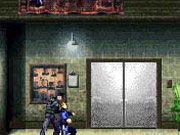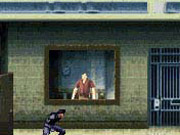Tom Clancy's Splinter Cell for the N-Gage, based on Ubisoft's blockbuster stealth action game, is a faithful port of the Game Boy Advance version that was released in the first half of this year. For good measure, though, some wireless multiplayer options have been tacked-on to the N-Gage version. It's a side-scrolling 2D action game, reminiscent of platformers and side-scrolling shooters from the 16-bit era, yet it borrows the premise and many gameplay elements from the core versions of Splinter Cell. The game does somehow preserve some of the original's frustrating qualities, and, furthermore, it's short and pretty repetitive. Nevertheless, it's a decent enough game, on its own merits, to tide over Splinter Cell fans who are looking for a portable version. For better or worse, it's also one of the more commendable action games so far on Nokia's system.

Splinter Cell for the N-Gage essentially is a retelling of the original game: You play as Sam Fisher, an ultrasecret government commando working for an organization that operates above the law, sending its agents into dangerous situations in the name of national security. Fisher must rely primarily on stealth as he works his way, alone, to the heart of heavily defended enemy compounds. Unless you've played the original, you'll have trouble comprehending the disjointed plot of the N-Gage version, which gives you a page of text as a preface to each of the game's nine missions, and that's about it in terms of the storyline. No matter, since this is a pure action game anyway, and it doesn't really need a story to tie together its scenarios. Nevertheless, some more context for the various objectives in the game would have been welcome.
As in the original, in Splinter Cell for the N-Gage, the object of most sequences is to try to get to the end while avoiding detection. Since this is a side-scrolling 2D game, though, obviously you can't just maneuver around your enemies. So the stealth mechanic boils down to monitoring the fixed side-to-side patrols of enemy guards and walking up behind them and bopping them on the heads while their backs are turned. The game controls pretty well, though double-tapping on the directional pad to start running can be a little awkward. The 4 key functions like a telescopic view, allowing you to scroll the screen in any direction and thus see farther than your enemies. Time is almost never a factor, so you can inch your way through most levels, playing it safe. Enemies come in a few varieties, but all are pretty stupid and have lots of trouble fighting you toe-to-toe. Security cameras pan from side to side, slowing your progress as you avoid their arc by sneaking under them as they're facing the opposite direction. Locked doors and safes and, later, automated sentry guns will sometimes bar your passage, but these can all be disarmed via a slightly different lock-picking minigame in each respective case. Splinter Cell for the N-Gage also has some basic platforming elements in it, which are made obvious right in the first level, where you'll have to leap from one vertical pipe over to the next while trying to avoid dangerous objects in the environment--such as searing flames, in this case.
There's a pretty good amount of variety outside of the core gameplay. Sometimes you'll be rappelling down buildings, trying to avoid detection by the guards passing each windowsill. In another sequence, you're chasing a hacker who's desperately trying to escape. Another scene has you fleeing a sinking ship, while another puts you in a food processing plant, jumping from meat hook to meat hook. Plus, there are a few first-person sniping sequences, which make for a nice change of pace.
The thing is, most every gameplay element in Splinter Cell can qualify as a "nice change of pace" at best. No part of the gameplay is particularly satisfying, not even the core sneaking. You can duck into shadows to avoid patrols, but this rarely comes into play. You can't pick up and drag bodies, but guards will flat-out ignore any unconscious bodies along their patrol, so it doesn't matter. There's a good reason why most 16-bit side-scrolling action games emphasized pure action instead of stealth--it's just more fun to go blasting through a bunch of bad guys than it is try to tiptoe up behind them and bop them on the head. As if to add insult to injury, in Splinter Cell you're always very low on ammo for your pistol (for game balance reasons, since the pistol lets you easily dispatch any enemy from afar), and you don't even get to use Fisher's signature SC-20K experimental rifle, except in the sniping minigame. So, only because Splinter Cell does have some variety to it will the game hold your interest even for the short five hours or so it'll take you to finish. It's not a long game by any stretch, but even still, Splinter Cell's length is padded out by repetitive level design and some trial-and-error sequences that you'll inevitably fail a number of times before you even figure out what's going on.
All this isn't to say Splinter Cell for the N-Gage is poorly done. On the contrary, it's quite well executed given the developers' constraints of having to bring the original Splinter Cell's gameplay into a side-scrolling 2D format. If anything, it's too bad the developers were limited by this design, as the stealth elements hurt the pacing here more often than they create suspense. This game probably would have been more fun as a pure shooter. Give Fisher his SC-20K and fill the screen with bad guys. Stealth be damned.
Someday, the fact that the N-Gage version of Splinter Cell is the first to offer multiplayer modes will make for a great game-trivia question. Two different two-player modes are available: teamplay and sniper. Each, of course, requires that both players have an N-Gage and a copy of Splinter Cell, which is playable over the airwaves by using Bluetooth technology. The sniper mode is just a two-player version of the sniping minigame, and it gets old rather fast, just like the single-player version. The both of you have a limited amount of time to kill as many bad guys in an office building as possible, and whoever smokes more bad guys (ideally, without gunning down any innocents) wins. Teamplay is more interesting, since it lets you engage in two-player cooperative versions of some of the game's main levels. As mentioned, though, this feels pretty tacked-on. Splinter Cell is designed to be a single-player game, so having two Sam Fishers running around (actually, player two is a different character) is merely a liability. If either player dies, it's game over for both. It's a cool idea being able to play a two-player portable game without any wires attaching the two systems, but in practice, two-player Splinter Cell is laggy, thus making the timing-based action pretty annoying.

The original version of Splinter Cell received much praise for the quality of its visuals, and though the N-Gage version can't be expected to measure up in this regard, it does look pretty impressive for a portable game. Fisher animates smoothly, especially while walking, running, and drawing and holstering his pistol. A few animations, such as when he pulls himself up onto a ledge, look a little choppy, but for the most part Fisher looks great in action. He's even got his combination night-vision/thermal-vision goggles, complete with graphical effects reminiscent of the original game, though the device doesn't come into play often. The environments in the game also look good, though the predominantly industrial settings of the game didn't leave the artists much room for creativity. Meanwhile, the game's audio is solid and mostly consists of a smattering of sound effects sampled from the original game, such as when Fisher draws his gun or clambers across a hanging pipe. Bass-heavy music drones in the background, helping to establish the mood. On the other hand, for some reason your enemies all exclaim "Hey!" when they spot you, even though they're supposed to be foreign.
There are a few unlockable bonus missions in the game. But chances are, by the time you've finished the core missions, you'll have had your fill of the game's formula, as well as its little diversions like the lock-picking and the sniping. It's all mostly fun while it lasts, though. Splinter Cell for the N-Gage is ultimately a good effort at trying to capture the original game's suspenseful gameplay in a 2D side scroller--making for a different sort of action game--as well as a pretty faithful adaptation of Splinter Cell's original design.